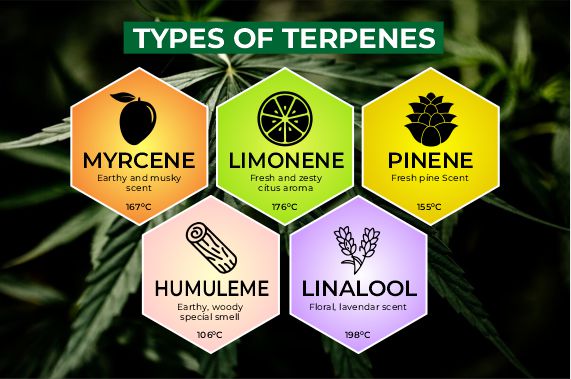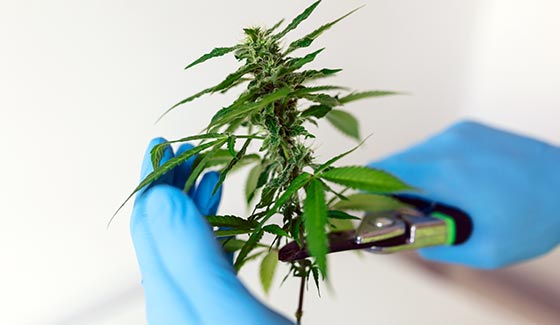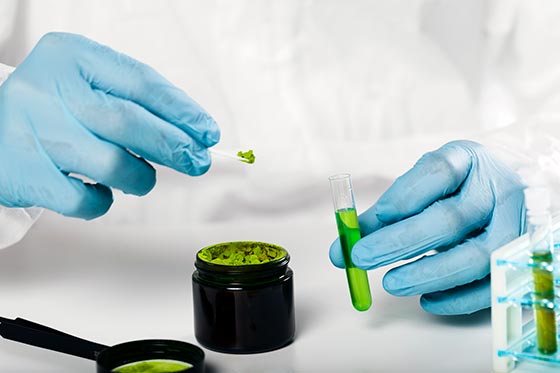
This blog post offers an insightful exploration of cannabis, specifically focusing on one of its most intriguing components: terpenes. Commonly known for their distinctive fragrances, terpenes play a pivotal role in the unique effects and therapeutic potentials of different cannabis strains. We’ll get into the science behind these aromatic compounds and highlight some of the most prevalent terpenes found in cannabis. We will also discuss their potential effects and the types of products where they are ingredients.
Terpenes are aromatic compounds found in various plants, including cannabis. They are primarily responsible for distinguishing scents and flavors associated with different plant species.
There are over 100 different terpenes found in cannabis. Each strain may have a unique combination and concentration of terpenes, contributing to its distinct aroma and potential effects. Some common terpenes found in cannabis include myrcene, limonene,
caryophyllene, linalool, and pinene, but the variety extends well beyond these examples. The specific terpene profile of a cannabis strain is one of the factors that contribute to its unique characteristics and the overall experience it provides to users.

Terpenes in the cannabis plant thrive within specialized structures known as trichomes. These microscopic, hair-like structures cover the surface of the cannabis plant, giving it a crystalline or frosty appearance. Trichomes house various bioactive compounds, including terpenes and cannabinoids like THC (tetrahydrocannabinol) and CBD (cannabidiol). The synthesis of terpenes and cannabinoids within the same trichomes highlights the intricate biochemistry of these glandular structures.
Trichomes act as the epicenter for the production of chemical compounds, contributing to their unique scent, flavor, and therapeutic properties. This close association of terpenes with cannabinoids in the trichomes reinforces the idea that these compounds work synergistically, contributing to the overall effects of the cannabis plant, a concept often referred to as the “entourage effect.” Understanding the role of trichomes provides valuable insights into the complex nature of the cannabis plant’s chemistry.
Cannabis exhibits a rich diversity of terpenes, each contributing unique aromatic characteristics. Common terpenes found in cannabis include myrcene, limonene, and pinene, each imparting distinct olfactory notes to the overall profile.
The ‘entourage effect’ is a theoretical framework suggesting that cannabinoids and terpenes in cannabis work synergistically. This collaboration enhances the overall effects of the plant, going beyond the individual impact of isolated cannabinoids like THC or CBD.
Terpenes play a crucial role in shaping the sensory experience of consuming cannabis. The variety and concentration of terpenes contribute to the diverse flavors and aromas found in different cannabis strains.
Research indicates that the entourage effect may have therapeutic implications. The intricate interplay between cannabinoids and terpenes creates a more nuanced and potent overall effect, potentially influencing the therapeutic benefits of the cannabis plant.
Understanding the interaction between cannabinoids and terpenes highlights the importance of a holistic approach to studying the effects of cannabis. This approach recognizes that the overall impact of the plant involves a complex interplay of multiple compounds.

As research in cannabis science progresses, there is a growing appreciation for the role of terpenes. This area of study contributes to a deeper understanding of the pharmacological effects of different cannabis varieties, impacting both recreational and medical users.
The study of terpenes in cannabis represents an intriguing convergence of botany, chemistry, and pharmacology. This research not only enhances our scientific understanding but also contributes to the cultural and social significance of cannabis as a widely consumed and valued plant.
For a deeper understanding, Russo’s 2011 study “Taming THC: potential cannabis synergy and phytocannabinoid-terpenoid entourage effects” in the British Journal of Pharmacology offers comprehensive insights.
Terpenes play a pivotal role in shaping the overall cannabis experience. These are five common terpenes found in cannabis—Myrcene, Limonene, Caryophyllene, Linalool, and Pinene—each with a distinct aroma and purported effects. Myrcene offers an earthy relaxation experience, and limonene is a citrus uplift. Caryophyllene has a peppery warmth to it. These terpenes are not just for sensory experiences. They also have therapeutic benefits!

Myrcene, an abundant terpene in cannabis, is distinguished by its earthy and musky notes. This compound is often associated with relaxation and sedation, making it a key player in strains such as Mango Kush and Blue Dream. As consumers explore the diverse world of cannabis, understanding myrcene’s presence in these strains provides valuable insights into the potential calming and stress-relieving effects they may experience. The unique aromatic profile created by myrcene contributes to the overall sensory experience, offering users a distinctive and soothing encounter with these particular cannabis varieties.
Limonene, characterized by its vibrant citrusy aroma, is believed to have mood-elevating properties and is considered a potential stress reliever. Found prominently in strains like Super Lemon Haze and Durban Poison, limonene adds a refreshing and uplifting element to the overall cannabis experience. Beyond the sensory allure, users may seek these strains for their potential therapeutic benefits, aiming for a more positive mood and reduced stress levels. The interplay between limonene and other compounds in these strains creates a complex profile, showcasing the diverse facets of cannabis consumption.
Caryophyllene, known for its distinctive peppery and spicy scent, is recognized for its anti-inflammatory and analgesic properties. Strains such as GSC (Girl Scout Cookies) and OG Kush boast a rich caryophyllene content, contributing to their aromatic complexity and offering users relief from inflammation and pain. Exploring strains with high caryophyllene levels may appeal to individuals seeking sensory satisfaction with therapeutic benefits.
Linalool is known for its floral and lavender aromas. It stands out as a terpene associated with anxiety relief and sedation. Strains like Amnesia Haze and Lavender, rich in linalool, offer users a potential pathway to a calming and soothing cannabis experience. Beyond the olfactory delight, these strains may attract individuals seeking relaxation and stress reduction. The unique contribution of linalool to the terpene profile of these strains underscores the intricate relationship between aroma and potential effects, providing users with a more comprehensive understanding of the diverse therapeutic possibilities cannabis may offer.

Pinene, aptly named for its pine-like aroma, is associated with increased alertness and memory retention. Strains like ‘Jack Herer’ and ‘Dutch Treat’ contain high levels of the Pinene terpenes. They provide users with a refreshing and invigorating experience. Beyond the sensory appeal, these strains may attract those seeking heightened focus and cognitive effects. Pinene’s role in shaping the overall experience of these strains demonstrates the complexity of cannabis, where individual terpenes contribute to a nuanced encounter for consumers.
For scientific details and anecdotal evidence on these terpenes, Russo and Marcu’s 2017 work in Advances in Pharmacology is a valuable resource.
Within the dynamic landscape of marijuana products, a notable focal point has emerged: the emphasis on specific terpenes within cannabis products. These aromatic compounds, responsible for the distinctive scents and flavors in cannabis, play a crucial role in shaping the effects and overall therapeutic qualities of cannabis products. This emphasis marks a significant evolution in consumer awareness and the industry’s commitment to delivering diverse and nuanced cannabis experiences.

The interaction between different terpenes and cannabinoids, such as THC and CBD, gives rise to what is known as the entourage effect. This collaborative synergy enhances the overall user experience of cannabis products. The combined effects of terpenes and cannabinoids create a more comprehensive and nuanced impact than the isolated compounds, offering consumers a holistic and multifaceted encounter with cannabis.
1. Oils
Concentrated extracts providing versatile consumption options.
Terpenes in cannabis oils contribute to the product’s overall profile, enhancing its flavor and aroma. For instance, a high myrcene content might make an oil product more suitable for evening use, promoting relaxation. Limonene can bring a citrusy brightness to the oil, potentially contributing to a more uplifting experience.
2. Tinctures
Liquid formulations provide precise dosing and quick absorption. In tinctures, terpenes contribute to the overall taste and impact the speed and efficiency of absorption. For example, a product with myrcene may offer a more calming effect, while one with limonene could provide a quicker and potentially uplifting experience. The precision of dosing in tinctures allows users to tailor their experience based on the terpene profile.
3. Topicals
External applications targeting localized relief. Terpenes in cannabis topicals add another layer to their therapeutic potential. Beyond the potential benefits of cannabinoids, terpenes like caryophyllene, known for its anti-inflammatory properties, can enhance the topical’s effectiveness in providing targeted relief. The aroma of the topical is also influenced by terpenes, contributing to a more pleasant application experience.
4. Edibles
Infused products offering a discreet and varied culinary experience. Terpenes play a pivotal role in the sensory experience of cannabis-infused edibles. Their influence on flavor can transform a simple gummy or chocolate into a nuanced culinary delight. Additionally, the specific terpenes present can contribute to the desired effects of the edible, whether it’s myrcene for a relaxing evening treat or pinene for a great start to the day.


Ensuring the reliability and accuracy of cannabis products is paramount. Lab testing and accurate labeling play a crucial role in this regard.
These practices provide consumers with precise information about the terpene profile of a product. Through reliable testing methods, consumers can make informed choices based on their desired effects, fostering transparency and trust in the relationship between consumers and cannabis brands. This commitment to quality assurance contributes to the safety and satisfaction of those exploring the diverse world of cannabis products.
Leading cannabis brands recognize the significance of terpenes in shaping the user experience. They often provide a range of products with distinct terpene compositions. Offerings cater to diverse preferences and therapeutic needs, such as calming Indica-dominant or sativa-dominant products for increased alertness.
Understanding and appreciating the role of terpenes adds depth to the sensory exploration of cannabis. It contributes to a more tailored and personalized approach to cannabis consumption in this evolving landscape.
A comprehensive review of cannabis ethnopharmacology by Bonini et al. in the Journal of Ethnopharmacology (2018) discusses the importance of these compounds in cannabis products.
As we venture into cannabis products, the emphasis on specific terpenes within oils, edibles, tinctures, and topicals becomes evident. The ‘entourage effect’ extends to these products, influencing the overall user experience. The importance of lab testing and accurate labeling are vital. It ensures consumers have precise information about the terpene profile, enabling informed choices based on desired effects.
For leading cannabis brands, recognizing the significance of terpenes has resulted in a wide array of products with distinct terpene compositions. This aspect reflects an evolving landscape where understanding and appreciating terpenes contribute to a more personalized approach to cannabis consumption.
As advancements in cannabis science progress, the study of terpenes adds depth to our scientific understanding and contributes to the cultural and social significance of cannabis.
1. Russo, E. B. (2011). Taming THC: potential cannabis synergy and phytocannabinoid-terpenoid entourage effects. British Journal of Pharmacology, 163(7), 1344-1364.
2. Russo, E. B., & Marcu, J. (2017). Cannabis Pharmacology: The Usual Suspects and a Few Promising Leads. Advances in Pharmacology, 80, 67-134.
3. Bonini, S. A., Premoli, M., Tambaro, S., Kumar, A., Maccarinelli, G., Memo, M., & Mastinu, A. (2018). Cannabis sativa: A comprehensive ethnopharmacological review of a medicinal plant with a long history. Journal of Ethnopharmacology, 227, 300-315.